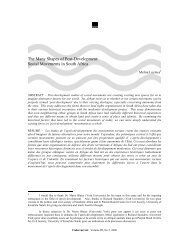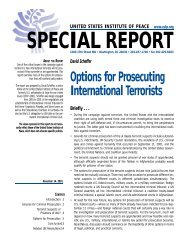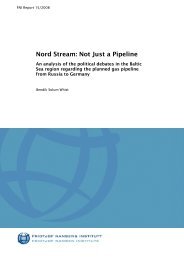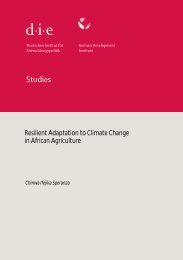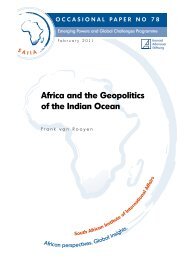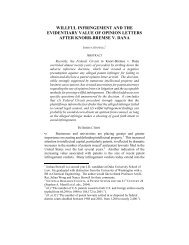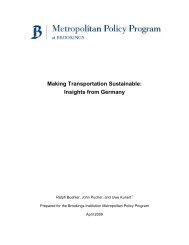equity implications of health sector user fees in tanzania
equity implications of health sector user fees in tanzania
equity implications of health sector user fees in tanzania
Create successful ePaper yourself
Turn your PDF publications into a flip-book with our unique Google optimized e-Paper software.
EXECUTIVE SUMMARY<br />
1. Background<br />
Early 2004, Research for Poverty Alleviation (REPOA) commissioned ETC Crystal to exam<strong>in</strong>e the<br />
<strong>equity</strong> <strong>implications</strong> <strong>of</strong> <strong>health</strong> <strong>sector</strong> <strong>user</strong> <strong>fees</strong> <strong>in</strong> Tanzania, with particular reference to proposed and<br />
actual charges at dispensary and <strong>health</strong> centre level. This year, Tanzania will review its Poverty<br />
Reduction Strategy. With the f<strong>in</strong>d<strong>in</strong>gs <strong>of</strong> the <strong>user</strong> fee study, REPOA aims at mak<strong>in</strong>g a valuable<br />
contribution to the review process and provide country-specific <strong>in</strong>sight <strong>in</strong>to one <strong>of</strong> the most debated<br />
issues <strong>in</strong> <strong>health</strong> f<strong>in</strong>anc<strong>in</strong>g.<br />
2. Methodology<br />
The focus and design <strong>of</strong> the study was formulated <strong>in</strong> close cooperation with the Research and<br />
Analysis Work<strong>in</strong>g Group <strong>of</strong> REPOA. The strategies for data collection comprised: (1) a comprehensive<br />
literature analysis literature, (2) semi-structured <strong>in</strong>terviews with resource persons from the government<br />
<strong>of</strong> Tanzania, multi- and bilateral donors, research <strong>in</strong>stitutes and NGOs <strong>in</strong> Dar Es Salaam, and (3) a<br />
case study <strong>in</strong> Kagera Region, <strong>in</strong>clud<strong>in</strong>g both document analysis and semi-structured <strong>in</strong>terviews with<br />
resource persons from the MOH, NGOs, FBOs, <strong>health</strong> workers and <strong>health</strong> care consumers from<br />
vulnerable and poor population groups. The study team developed multiple tools for data collection<br />
and analysis <strong>in</strong>clud<strong>in</strong>g: (1) a data matrix for categorisation and identification <strong>of</strong> key issues, (2)<br />
guidel<strong>in</strong>es for the <strong>in</strong>terviews <strong>in</strong> Dar Es Salaam, (3) guidel<strong>in</strong>es for data collection and <strong>in</strong>terviews <strong>in</strong><br />
Kagera Region, and (4) a tool for the analysis <strong>of</strong> poverty reduction strategy documents. A total number<br />
<strong>of</strong> 170 <strong>user</strong> fee-related documents were assessed, <strong>in</strong>clud<strong>in</strong>g those cover<strong>in</strong>g the experience from<br />
neighbour<strong>in</strong>g countries. Seventy-n<strong>in</strong>e resource persons participated <strong>in</strong> the study.<br />
3. Ma<strong>in</strong> f<strong>in</strong>d<strong>in</strong>gs and recommendations<br />
1. Resources generated by <strong>user</strong> <strong>fees</strong> and their use at hospital, district council and PHC levels. The<br />
study team found that reliable, transparent <strong>user</strong> fee <strong>in</strong>come data for district, hospital and PHC<br />
level were difficult to obta<strong>in</strong>. Based on what <strong>in</strong>formation is available, the team concludes that<br />
revenues raised from <strong>user</strong> <strong>fees</strong> at the hospital level have been lower than what has been<br />
projected. Furthermore, the data reflect huge variations between facilities and a decl<strong>in</strong>e <strong>in</strong> the<br />
revenues from cost shar<strong>in</strong>g. The reasons <strong>of</strong> the reported decl<strong>in</strong>e are unclear. The data<br />
reflect<strong>in</strong>g the contribution <strong>of</strong> <strong>user</strong> <strong>fees</strong> and CHF to the <strong>health</strong> budget at district council level<br />
show huge variations as well. The reported <strong>user</strong> fee <strong>in</strong>come proportion for the district <strong>health</strong><br />
budget was on average 10.5%. The study team could not establish how the <strong>in</strong>come from cost<br />
shar<strong>in</strong>g and the CHF was re-distributed by the council to PHC facilities or priority areas. A<br />
worry<strong>in</strong>g f<strong>in</strong>d<strong>in</strong>g was that some councils did not spend all <strong>health</strong> resources <strong>in</strong> the <strong>health</strong> <strong>sector</strong>.<br />
The study team observes an urgent need for: (1) more accurate and comprehensive record<br />
keep<strong>in</strong>g at local council level, and (2) more cost<strong>in</strong>g and track<strong>in</strong>g studies to obta<strong>in</strong> a better<br />
<strong>in</strong>sight <strong>in</strong>to cost shar<strong>in</strong>g and expenditures and to adequately <strong>in</strong>form policy mak<strong>in</strong>g.<br />
2. Contribution <strong>of</strong> <strong>user</strong> <strong>fees</strong> and CHFs to the <strong>health</strong> resource envelope. The study team concludes<br />
that the national projections <strong>of</strong> the cost shar<strong>in</strong>g schemes do not reflect an accurate picture,<br />
s<strong>in</strong>ce the data are based on the <strong>in</strong>accurate f<strong>in</strong>ancial data received from the districts. It is likely<br />
that the actual and projected data on <strong>user</strong> <strong>fees</strong>, CHFs and HSF are underestimations <strong>of</strong> the real<br />
<strong>in</strong>come collected at the different facility levels. This means that the MOH faces a loss <strong>of</strong> <strong>in</strong>come<br />
that cannot be redistributed to the <strong>health</strong> <strong>sector</strong>. It also implies that people (both wealthy and<br />
poor) are likely pay more than what is <strong>of</strong>ficially reported. The actual potential and use <strong>of</strong> the<br />
non-reported <strong>user</strong> <strong>fees</strong> are not known. The total contribution <strong>of</strong> the cost shar<strong>in</strong>g schemes<br />
(exclud<strong>in</strong>g NHIF) to the national <strong>health</strong> resource envelope for FY03/04 is 1.67 Billion Tshs. This<br />
equals a contribution <strong>of</strong> 0.6% to the overall budget for the <strong>health</strong> <strong>sector</strong>. In total, this is US$ 1.56<br />
million. Given the size <strong>of</strong> the total <strong>health</strong> budget (US$ 260 million), it can be concluded that the<br />
<strong>of</strong>ficially reported <strong>user</strong> <strong>fees</strong> contribute a small proportion only. The actual revenue generated<br />
does not meet the <strong>in</strong>itial expectations.<br />
3. Contribution <strong>of</strong> revenues generated to improved services. The study team found limited positive<br />
evidence that <strong>user</strong> <strong>fees</strong> <strong>in</strong> Tanzania have <strong>in</strong> general achieved their orig<strong>in</strong>al objectives <strong>of</strong><br />
susta<strong>in</strong>ability, drug availability, quality <strong>of</strong> care, <strong>equity</strong> and access for the poor. More specifically,<br />
Equity Implications <strong>of</strong> Health Sector User Fees <strong>in</strong> Tanzania v






